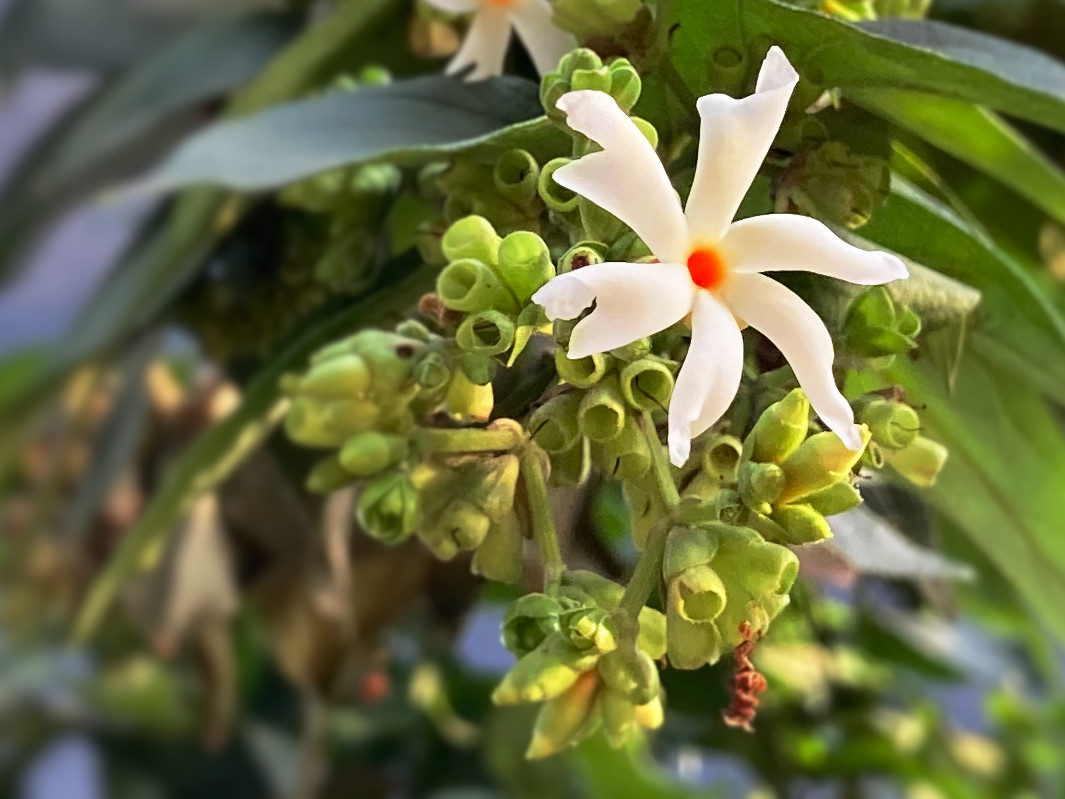The days turn shorter. There is a cool mist in the early mornings. An Indian autumn is in the air. A rather untidy, nondescript tree in a corner of the garden tentatively puts forth a cluster of blooms – white stars on jaunty orange stalks. The sheuli. Others may know it as the parijat, the harshringar or the night-flowering jasmine. The flower of autumn. The flower of the gods, derived from the churning of the oceans and brought to earth by Lord Krishna.

The tiny flower has magical properties. A mere whiff of its exquisite fragrance, a little chemistry at the olfactory ends, and I am transported across five decades and the breadth of the country effortlessly!
Time travel to my childhood home
I land in the rambling garden of my childhood home under the tall sheuli tree, which stood sentinel over straggling chrysanthemums and rose bushes. My mother liked her trees tall and straight, and had the branches pruned so that the tree grew tall and conifer-like. There it stood the year round, unremarkable, undemanding, and rather plain. Only as the earth cooled and the season changed did the tree awaken. We held our breath in anticipation, our eyes scanning the branches for the first, the very first flower of autumn.
It never let us down. Though none of us could ever pinpoint the day, we knew with certainty that the parijat would bloom, showering its flowers on the dew-dampened earth while releasing its fragrance to the heavens.
You had to be up at daybreak if you wanted to collect them fresh, and tiptoe carefully amidst the fragile blooms to scoop them up into wicker baskets. A good shake of the sturdy trunk and you could stand in the flurry of the showering blooms, and pretend you were in the midst of a scented, starry snowstorm. Then race upstairs to weave them into garlands – simple single-stranded ones and thick cable-like ones; the orange stalks staining fingers yellow. We willed them to last, lovingly enfolding them in moist soft muslin, but they would wilt, for, as my grandmother said, who can go against the will of the gods?
Parijat and the Sun God
For Parijat loved the sun-god, who married her on the condition that she would never flinch from his glare. One hot summer, she did. Turned into a tree, she could only bloom and meet her love in the darkness of a cool autumn night; and was fated to die in the heat of the rising sun.
But even in death, the flowers left their mark. The orange stalks could be dried and boiled in water to yield a lovely yellow dye. One autumn, in a burst of enthusiasm, we dyed all the white handkerchiefs we could find in the house, including a batch of pristine new ones!
Unfortunately, the leaves of the sheuli is the favoured food of a species of moth with a hairy, bristly larval stage, and after a particularly heavy scourge, my father had the tree felled and burnt. I came home from college and found a vacant spot in the garden – and an empty place in my heart.
Five decades later, across the breadth of the country, the flower of autumn blooms again, in time for the homecoming of the goddess Durga. As it does every year and always will. Its fragrance wafts in the breeze, the flowers carpet the gravelly road; and an old man picks them up tenderly in his not-so pristine hanky – to be put at the feet of the Gods.
